Brazil’s Atlantic Forest
is one of the most imperiled on the planet.
Brazil’s Atlantic Forest has suffered from wide-scale deforestation with barely five percent of the original forest cover remaining. What remains of the once great Atlantic Forest of Brazil is a patchwork of remnants that are the last refuge for some of the greatest wealth of biodiversity on the planet.
Sixty percent of Brazil’s endangered species are in the Atlantic Forest. In total, there are 24,000 species of plants, mammals, birds, and amphibians, and reptiles, of which 9,500 species exist nowhere else on earth. Importantly, there are also countless more unknown to science.
As the forest continues to dwindle, the increasingly stranded species have been called “the living dead” by Brazilian conservationist Antonio Rossano Mendes Ponte.
For over a decade, the team at Saving Nature has worked to restore and protect biodiversity in the Atlantic Forest of Brazil.
Having already completed two highly successful corridors, we are actively working to create our third. This new corridor builds on our prior gains, including our flagship corridor for golden lion tamarins and our connection to Brazil’s first forested highway bridge for wildlife crossings.
The new corridor will enable wildlife to move through and beyond to a 250,000-acre forest block. This connection safeguards a vital watershed for the residents of Rio de Janeiro, builds habitat for biodiversity, and sequesters carbon dioxide to fight climate change.
We have completed the first phase of the corridor with 823 acres of land purchased, restored, and protected. We are now making steady progress to complete the corridor.
Atlantic Forest Corridor Goal
Corridor Goal
1,544 acres
Progress to date
823 acres
Remaining land needed
721 acres
Cost per Acre
$1,500
THE ATLANTIC FOREST CORRIDOR
5%
Percent of Forest Remains
24,000
Species Protected
823
Acres Restored
807,662
Trees Planted
4,845
Tons CO2 removed per year
We hope our long-term commitment and collaborative approach among local conservation organizations, zoos, local communities, individuals, and governments working in the Atlantic Forest of Brazil to save this vanishing ecosystem and its biodiversity will serve as a model for how to achieve effective and efficient ecosystem protection and restoration through cooperation and strategic action.
In 2019, Saving Nature partnered with Reserva Ecológica de Guapiaçu (REGUA), a leading Brazilian conservation organization, to restore strategic connections among small isolated forests that run along the Vecchi Ridge, a 16 km (10-mile) patchwork of forests on hilltops and croplands. In this now mixed landscape of farmland, fragmented forests, and new housing developments, it is the only real hope for gene pools of stranded biodiversity to move around. The mountains inland of REGUA are relatively well protected and form a horse-shoe-shaped backdrop to the project. Much of the work here involves protecting the foothills.
The main goals of the Project are: a) improve connectivity and / or continuity of forest cover to achieve positive outcomes for biodiversity at the community and landscape levels; b) improve the conditions of conservation and protected area management at the regional level, including better community resilience to climate change; c) become the beacon for change to catalyze forest restoration through access to carbon financing for local communities, d) mitigate climate change; and e) recover watersheds.
To achieve the above goals, degraded lands are restored for conservation – activities that involve planting native tree species on non-forest lands for the purpose of forest conservation. Areas under the Project will protect the selected area for the duration of the Project and beyond, retaining the carbon contained in the existing biomass and sequestering additional carbon in the recovered forests.
The Project seeks to establish 625 hectares of reforested area. The Project uses site preparation and tree planting to establish native trees on degraded lands. The practice is to plant 675 native trees per acre (1,667 per ha). No harvesting is allowed within the Project area. The process starts with identifying which species to plant from adjacent forests, which are exceptionally rich in plant biodiversity.
The intended interventions are carried out in the Guapiaçu River sub-basin, a tributary to the Macacu River, located in the Baixadas Litorânea region, in the municipality of Macacu Waterfall – Rio de Janeiro, in the eastern portion of the Baía Hydrographic Basin from Guanabara. This sub-basin is limited to the north and west by the mountain range known as Serra dos Órgãos, an area with important forest fragments and water resources.
The Fazenda Dourada Corridor “The Golden Farm”
Our flagship project in Brazil’s Atlantic Forest launched in 2007 in partnership with Associação Mico-Leão Dourado (AMLD), a leading Brazilian conservation organization working to save the golden lion tamarins. Aptly named Fazenda Dourada, meaning golden farm, it was an important connection for golden lion tamarins and other species.
Twelve years in the making, it has become a functioning wildlife corridor, linking the isolated federal União Biological Reserve to forests to the west and at higher elevations. Today, the corridor and those forests to the west are now included in the much expanded reserve. Over time, the trees have matured into a continuous canopy connecting two forests over a road, creating a migratory pathway for the endangered golden lion tamarin and potentially thousands of other imperiled species to travel through previously degraded and fragmented landscapes.
Evidence of the Forest Returning Can Be Seen From Space
This corridor has become a model for future restoration projects in Brazil and other biodiversity hotspots around the world.” says Stuart Pimm, President of Saving Nature. “While the iconic golden lion tamarin served as the flagship species for this restoration because it’s such a charismatic animal, the model will also serve many other unique species.”
In 2019, we confirmed the corridor was working, with tamarins crossing into an area from which they had previously been absent. Foxes, crab-eating raccoons, otters, and birds also now live in the corridor. As shown in these Before and After photos, what was once a degraded, impassable landscape for the tamarins and other species is now a passage to more resources. As a result of the efforts by Saving Nature and our long-term local conservation partners, there is now considerably more accessible habitat.
The need for a better and safer highway connection between northern and southern Brazil created another potential challenge for golden lion tamarins and other species. Widening the BR-101 highway from two lanes to four risked creating a manmade barrier, virtually impossible for them to cross.
Fortunately, the Brazilian government had the foresight to require that the highway construction plant include a tree topped bridge across the new highway. Notably, the first of its kind in Brazil, the forested highway bridge creates a passageway for tamarins and other species trying to cross.
Completing the Connection
The only missing piece in the plan was the connection between the bridge and the Poço das Antas reserve. That’s where Saving Nature and our multi-year partnership with DOB Ecology and Associação Mico Leão Dourado (AMLD) come in! Together, we seized upon an extraordinary opportunity to capitalize on this innovative highway crossing. We began by identifying a strategic parcel of land located at the outlet of the bridge. Next, we raise the funds to acquire the property and set it aside for restoration.
The property we helped purchase on behalf of AMLD connects two large surviving fragments of Brazil’s Atlantic Forest and establishes an important gateway into the Golden Lion Tamarin Reserve. In addition, it creates a much needed safe zone for a host of species crossing the highway. This is an especially important step toward our vision to of having enough forest to support a viable tamarin population far into the future. Because of relentless threats from road development, healing the Atlantic Forest is the only hope for survival of golden lion tamarins and the wealth of biodiversity in the Atlantic Forest.
RRESTORATION WORK BEGINS…
While the bridge construction is underway, the team at AMLD has begun restoring the corridor. They have installed fencing to keep out grazing cattle and planted a mix of native trees. Over time, the young trees will mature, shading out the grasses and providing cover for species moving through the corridor.
Click here to see a panoramic image of the recovering corridor.
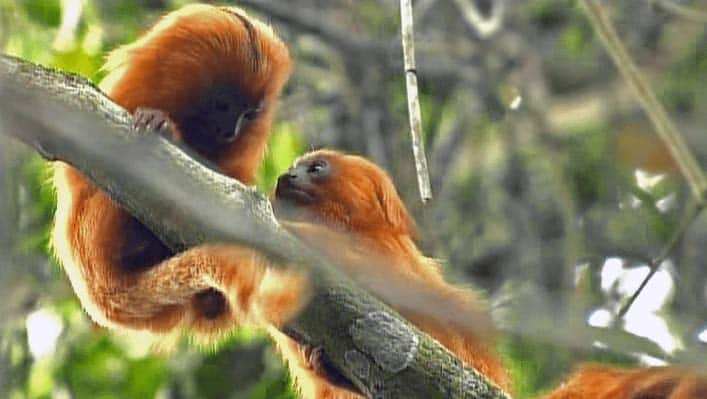
Their Heroic Struggle
Succumbing to deforestation and collection for the pet trade, this charismatic species had dwindled to 200 individuals in the wild by the late 1960’s – basically one catastrophe short of extinction.
With the wild population disappearing, they got an unexpected reprieve in the early 1980’s, thanks to an ambitious captive breeding and reintroduction program. Seeing the importance of returning golden lion tamarins to the wild, zoos stepped in to help. Joining forces, a network of zoos carefully managed the captive population genetics, ecologists studied habitat, and educators worked with local communities.
By 2007, the reintroduction stalled. Simply put, there wasn’t enough forest for any more tamarins. That’s when the team at Saving Nature helped changed that, joining the effort to save the golden lion tamarin by helping to connect, protect, and restore critical forest fragments. By making these connections, isolated golden lion tamarins would have access to larger forest expanses capable of supporting viable populations.
Our goal was ambitious – to reverse the damage of increasing forest fragmentation and save this irreplaceable primate. To do so, we partnered with Associação Mico-Leão Dourado (AMLD) to create connected lowland habitat that would sustain a viable population of golden lion tamarins. By 2016, the collective effort got results, with the population of tamarins growing steadily, a third of which being descendants of golden lion tamarins raised in human care.
Brazil embraced the golden lion tamarin as a national symbol on the 20 Reais bill. Golden lion tamarins went from a little-known and under-studied primate to a national symbol in Brazil, featured on a postage stamp and on the R$20 bil.
The Work Continues
Today, the work continues as the challenges to resiliency confronting small populations compound. The combination of ongoing habitat loss, expanding development, genetic drift, and anthropogenic diseases have reversed some of the gains. But don’t count this tenacious primate out just yet. As support grows, so do their prospects for a sustainable future.
A Bridge to Survival
To reconnect the surviving remnants of the Atlantic Forest of Brazil in São Paulo State, we teamed up in 2015 with the Institute for Ecological Research (IPÊ). Together, we are working to reforest the Rosanela Farm to create a network of three 7-hectare plots that will connect the Morro do Diabo State Park with the Black Lion Tamarin Ecological Station. We are working to remove barriers to biodiversity conservation within the productive landscape of the Atlantic Forest.
The project offers land use alternatives for smallholder settlements that integrate biodiversity-friendly and economically-viable practices. Funded by the Leonardo DiCaprio Foundation with a grant of $100,000, the Rosanela corridor is one stepping stone in IPÊ’s “Dream Map”, a plan for creating Brazil’s largest reforestation corridor. After ten years of effort, this larger corridor now links two main remnants of Atlantic Forest in the Pontal de Paranapanema region. Restored entirely on privately owned lands, it is approximately 7 kilometers long and averages 400 meters wide.
Project Goals
The specific goals of the project to restore the Rosanela Farm include a number of strategic objectives, including:
a) Reforest gaps in the main corridor between the Morro do Diabo State Park and the Black Lion Tamarin Station.
b) Plant 60,000 native trees of the Atlantic Forest.
c) Produce 200.000 seedlings in community-based nurseries to reforest that larger corridor.
d) Generate approximately $30,000 of income for participating families (100 settlers).
e) Provide technical training in agro-forestry and organic farming for over 100 farmers.
f) Offset approximately 10,200 tons of carbon dioxide.
Phase I Results
Since reforestation efforts began in 2016, all three plots have undergone a significant transformation from degraded agriculture to forested corridor. IPÊ has restored the first 7-hectares (Plot A on the map above) with a mix of tree planting and natural regeneration. Here, the team has catalyzed reforestation by planting 14,000 seedlings cultivated in community-based nurseries.
These plantings include about a dozen fast-growing succession species that promote soil coverage and improve environmental conditions near the ground for natural colonization of native tree species. As shown, in the figure below, Plot A has returned largely to forest. In addition, restoration of the first plot has produced 80,000 seedlings, generated more than $40,000 of income for community nurseries and trained over 80 farmers in agro-forestry and organic farming.
Phase 2 Restoration Plans
The second two plots (Plots B and C on the map above) require significantly more intensive efforts to reforest, as both had been under intensive mechanized agriculture with pastures dominated by exotic grasses and few regenerating seedlings and / or isolated trees. Here, the team at IPÊ has developed a plan to plant plant 2,000 seedlings / ha using at least 100 native species, including 10 native species for filling lines and 90 native species for diversity lines. Completing reforestation of the second two plots will create an important connection for black lion tamarins.
PHOTO CREDIT: Black lion tamarin photo by Miguelrangeljr – Own work, CC BY 3.0, https://commons.wikimedia.org/w/index.php?curid=20298970
« Prev1 / 1Next »
 VIADUTO VEGETADO MICO-LEÃO-DOURADO / GOLDEN LION TAMARIN WILDLIFE BRIDGE
VIADUTO VEGETADO MICO-LEÃO-DOURADO / GOLDEN LION TAMARIN WILDLIFE BRIDGE South American cougar (puma concolor)
South American cougar (puma concolor) Capybara (Hydrochoerus hydrochaeris)
Capybara (Hydrochoerus hydrochaeris) Lessor Grison (Galictis cuja)
Lessor Grison (Galictis cuja) Black-and-White Tegu (Salvator merianae – Teiu)
Black-and-White Tegu (Salvator merianae – Teiu) Southern Tamandua / Lesser Anteater (Tamandua tetradactyla) hitches a ride
Southern Tamandua / Lesser Anteater (Tamandua tetradactyla) hitches a ride Meet The Atlantic Forest of Brazil
Meet The Atlantic Forest of Brazil Capybara (Hydrochoerus hydrochaeris) Rumble in the Jungle Heavyweight Championship Bout
Capybara (Hydrochoerus hydrochaeris) Rumble in the Jungle Heavyweight Championship Bout Southern Tamandua / Lesser Anteater (Tamandua tetradactyla) looking for ants
Southern Tamandua / Lesser Anteater (Tamandua tetradactyla) looking for ants Happy World Tapir Day (April 27th)
Happy World Tapir Day (April 27th) Black-and-White Tegu Salvator merianae (Teiu)
Black-and-White Tegu Salvator merianae (Teiu) Capybara (Hydrochoerus hydrochaeris)
Capybara (Hydrochoerus hydrochaeris) Colors of Atlantic Forest« Prev1 / 1Next »
Colors of Atlantic Forest« Prev1 / 1Next »
help heal Brazil's atlantic forest

Our second corridor was generously supported by DOB Ecology, a charitable foundation based in the Netherlands. Their support for conservation projects in Latin American and Sub-Saharan Africa makes an incredible difference for biodiversity. Their concern for the Atlantic Forest of Brazil made it possible to capitalize on this unique opportunity. Together, we are amplifying AMLD’s progress from two decades of work to secure a future for golden lion tamarins.
Copyright 2025 Saving Nature | fGreen Theme powered by WordPress

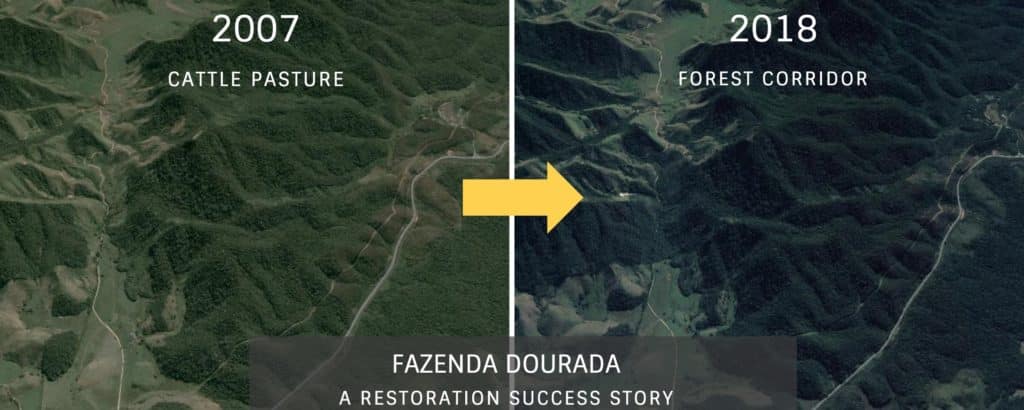
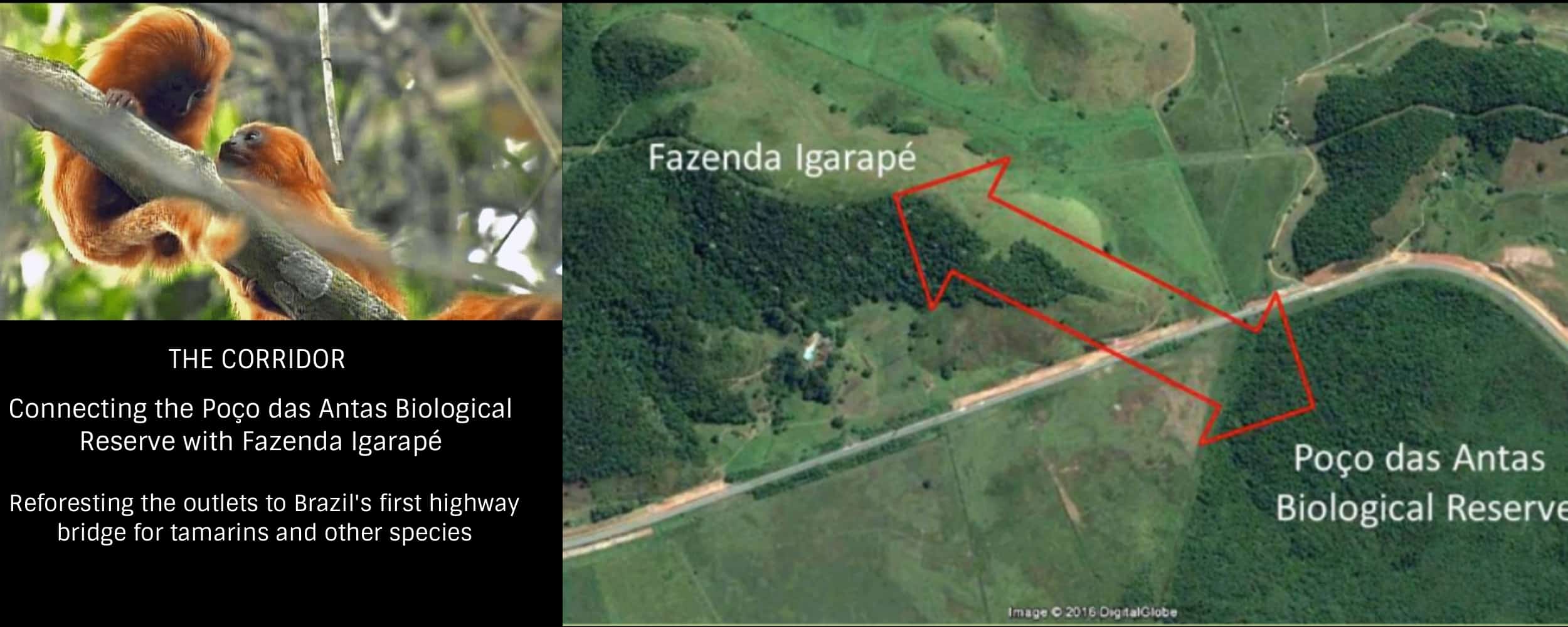
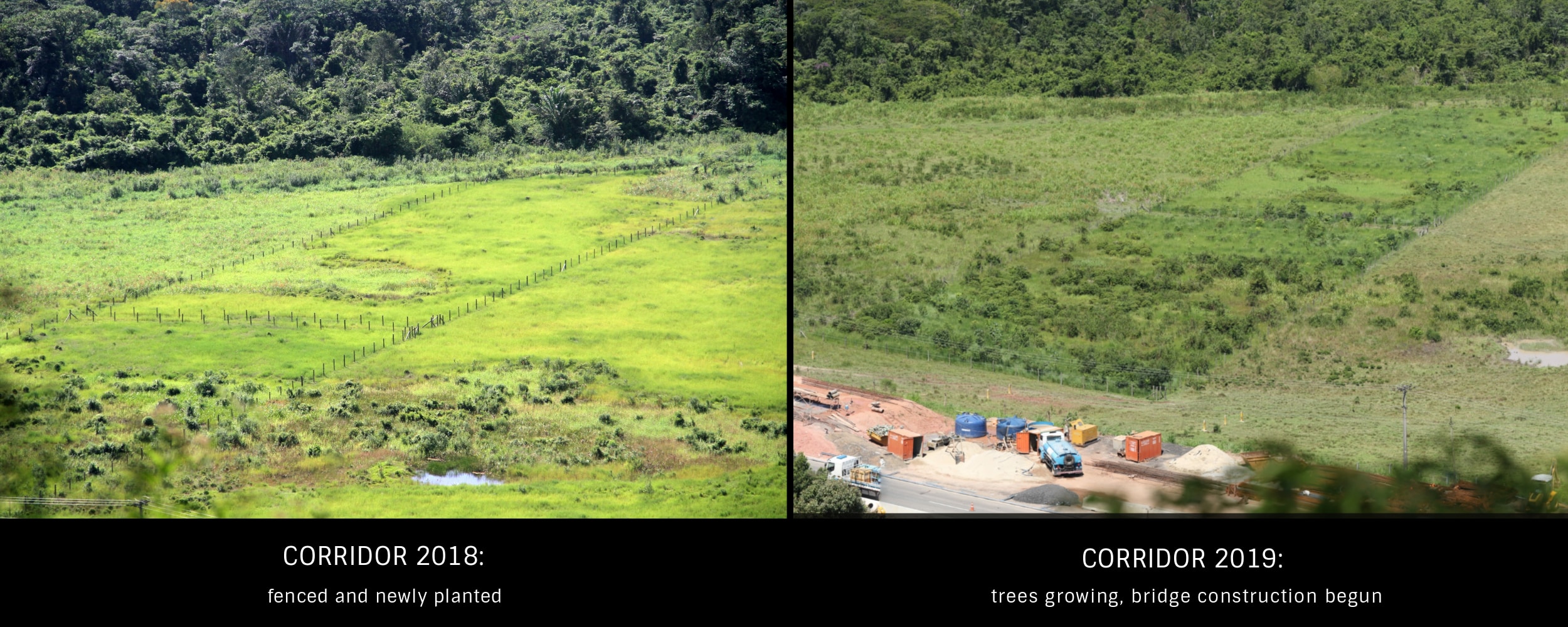
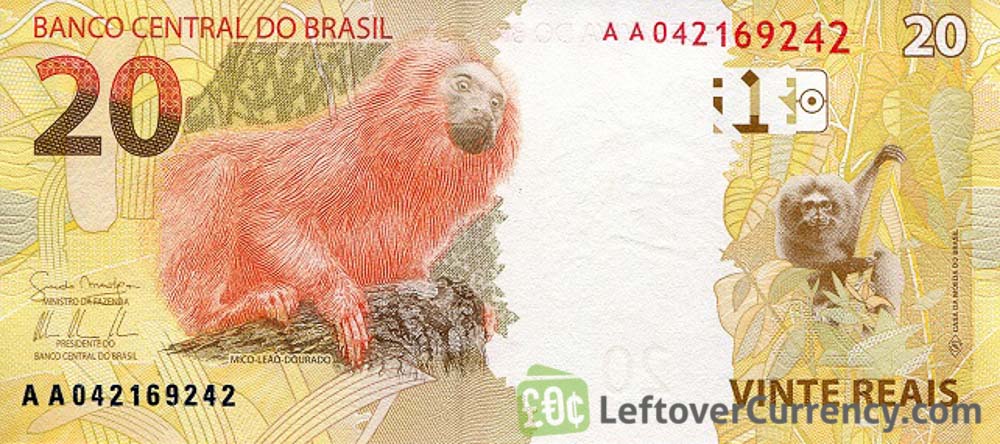
 Subscribe to our channel
Subscribe to our channel